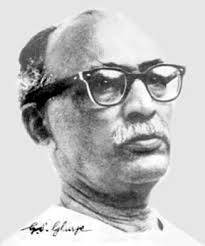Top Qs
Timeline
Chat
Perspective
G. S. Ghurye
Founder of Indian sociology (1893–1983) From Wikipedia, the free encyclopedia
Remove ads
Govind Sadashiv Ghurye (12 December 1893 – 28 December 1983) was a pioneering Indian academic who was a professor of sociology.[3] In 1924, he became the second person to head the Department of Sociology at the University of Bombay.[4] And, is widely regarded as the founder of Indian Sociology & Sociology in India.
Remove ads
Early life
G S Ghurye was born, in a Saraswat Brahmin community[5] on 12 December 1893, at Malvan, in present-day Maharashtra.[2] His early schooling was at the Aryan Education Society's High School, Girgaum, in Bombay, and then at Bahadur Khanji High School, Junagadh, in the princely state of Junagadh.[2] He joined Bahauddin college at Junagarh, in 1912, but moved on to Elphinstone College, Bombay, after a year, and received his B. A. (Sanskrit) and M. A. (Sanskrit) degrees from there.[6] He earned the Bhau Daji prize with his B. A., and the Chancellor's gold medal with his M. A. degree.[6] After completing his M. A., Ghurye received a scholarship for further studies in England, and earned his PhD from Cambridge University in 1922.[2] Ghurye was deeply influenced by W. H. R. Rivers, who was his PhD guide.[7] After Rivers' untimely death in 1922, he completed his thesis under A. C. Haddon.[7]
Remove ads
Personal life
Ghurye was married to Sajubai of Vengurla, a town near Malwan.[2] His son, Sudhish Ghurye is a Mathematician and Statistician, and daughter Kumud G. Ghurye was a barrister.[8]
Career
Summarize
Perspective
Ghurye was appointed as Head of the Department of Sociology in Bombay University in 1924, and retired in 1959.[9] The department was founded by Patrick Geddes in 1919.[10] However, when Ghurye took it over, it was on the verge of closure. The department came alive once again with Ghurye, and now, Ghurye is regarded as the real founder[11] and "shaped" the study of sociology there from then on.[12]
He also founded the Indian Sociological Society and its newsletter, Sociological Bulletin, and served as head for both.[13] He also headed the Bombay Anthropological Society for some years.[14]
After retirement, he served as Professor Emeritus for Bombay University and at least three festschrifts were produced in his honour, of which two were during his lifetime.[15] He guided a total of 80 research theses and authored 32 books and a number of other papers.[16] Later, at least two theses were written on him.[17]
Among his students were personalities like noted social reformer and intellectual Dr. Uttamrao K. Jadhav,[18] A. J. Agarkar, Y. M. Rege, L. N. Chapekar, M. G. Kulkarni, M. S. A. Rao, Iravati Karve, C. Rajagopalan, Y. B. Damle, M.N. Srinivas, A. R. Desai, D. Narain, I. P. Desai, M. S. Gore, Suma Chitnis and Victor D'Souza.[19] He also had the opportunity to see the "Dr. G. S. Ghurye Award" being instituted in his honour.[20] His book Caste and race in India is regarded as a classic in the field.[21]
Publications
- G.S. Ghurye (2008) [1932]. Caste and race in India. Popular Prakashan. ISBN 978-81-7154-205-5.[21]
- Govind Sadashiv Ghurye (1943). The aborigines -"so-called" – and their future. Pub. by D.R. Gadgil for the economics.
- G. S. Ghurye (1951). Indian costume, bhāratīya veṣabhūsā. the Popular book depot.
- Govind Sadashiv Ghurye (1952). Race relations in Negro Africa. Asia Pub. House.
- Govind Sadashiv Ghurye (1995) [1953]. Indian Sadhus. Puopular Prakashan, Bombay.
- Govind Sadashiv Ghurye (1956). Sexual Behaviour of the American Female. Current Book House.
- Govind Sadashiv Ghurye (1957). Caste and class in India. Popular Book Depot.
- Govind Sadashiv Ghurye (1958). Bhāratanāṭya and its costume. Popular Book Depot.
- Govind Sadashiv Ghurye (1960). After a century and a quarter: Lonikand then and now. Popular Book Depot.
- Govind Sadashiv Ghurye (1962). Cities and civilization. Popular Prakashan.
- Govind Sadashiv Ghurye (1962). Gods and men, by G. S. Ghurye.[permanent dead link]
- Govind Sadashiv Ghurye (1962). Family and kin in Indo-European culture. Popular Book Depot.
- Govind Sadashiv Ghurye (1963). The Mahadev Kolis. Popular Prakashan.
- Govind Sadashiv Ghurye (1963). Anatomy of a rururban community. Popular Prakashan.
- Govind Sadashiv Ghurye (1963). Anthropo-sociological papers. Popular Prakashan.
- Govind Sadashiv Ghurye (1965). Religious consciousness. Popular Prakashan.
- Govind Sadashiv Ghurye (1968). Social tensions in India. Popular Prakashan.
- Govind Sadashiv Ghurye (1973). I and other explorations. Popular Prakashan.
- Govind Sadashiv Ghurye (1974). Whither India?. Popular Prakashan.
- Govind Sadashiv Ghurye; S. Devadas Pillai (1976). Aspects of changing India: studies in honour of Prof. G. S. Ghurye. Popular Prakashan.
- Govind Sadashiv Ghurye (1977). Indian acculturation: Agastya and Skanda. Popular Prakashan.
- Govind Sadashiv Ghurye (1978). India recreates democracy. Popular Prakashan. ISBN 9780842616072.
- G. S. Ghurye (December 1979). Legacy of the Ramayana. South Asia Books. ISBN 978-0-8364-5760-5.[permanent dead link]
- Govind Sadashiv Ghurye (1979). Vedic India. Popular Prakashan.
- Govind Sadashiv Ghurye (1 January 1980) [1963]. The scheduled tribes of India. Transaction Publishers. pp. 1–. ISBN 978-0-87855-692-2.
- Govind Sadashiv Ghurye (1980). The burning caldron of north-east India. Popular Prakashan.
- G.S. Ghurye (1 January 2005). Rajput Architecture. Popular Prakashan. ISBN 978-81-7154-446-2.
Remove ads
References
Further reading
External links
Wikiwand - on
Seamless Wikipedia browsing. On steroids.
Remove ads

